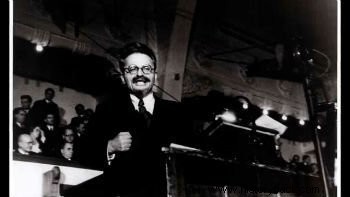Trotskyism is a leftist ideology based on the ideas of Leon Trotsky (1879-1940).
Characteristics
Trotskyism emerged from the reflections made by Leon Trotsky on Marxism and the Russian Revolution.
These ideas are expressed in several of Trotsky's books, but mainly "The theory of permanent revolution" (1929).
For him, the communist revolution could not be restricted to the Soviet Union. It should spread to other countries, especially those that were dependent on foreign capital.
For this reason, the working class should assume the vanguard of the changes, constituting political parties and unions where they could organize themselves and demand more rights.
If necessary, violence should be used to seize power. It would be up to the USSR to support the new revolutionaries with money and logistics.

Leon Trotsky stated that it was necessary to expand internationalist ideas against the nationalism that the world was experiencing in the 1930s. This thought is summarized in his famous phrase “socialism will be global or it will not be ”.
Trotsky's ideas were contrary to Stalin's ideas who wanted to make the revolution only in the immense Soviet territory.
Therefore, after Lenin's death, Stalin quickly distanced himself from Trotsky and his collaborators, sending them into exile or physically eliminating them. Stalin feared Trotsky's popularity as the commander of the Red Army.
Even so, Trotsky continues to write and becomes a critic of the Soviet state built by Stalin.
In the book “Revolution Betrayed ” (1937) he denounces that the bureaucratization of the Soviet state would stifle the revolution and the construction of socialism.
As Trotsky was not well regarded in the capitalist countries, the only one who agreed to house him was Mexico, where he would be assassinated at Stalin's behest.
Leninism vs. Trotskyism
The two leaders of the Russian Revolution had different views on a number of issues. Below we highlight three of them:
Political Alliances
Trotsky did not accept the alliance with the peasant movement as he considered it reactionary in nature.
In turn, Lenin maintained that this alliance was important, because if the peasant was not an enemy of the proletariat, he was its main ally and this union would help the revolution to triumph.
Party Structure
Trotsky did not agree with the monolithic structure of the Party. For him, anyone who wanted could take part in this structure, without the need to delve into left-wing ideas.
Revolutionary Stages
Trotsky also disagreed with the theory of stages within a revolution. Lenin claimed that it was necessary to pass a bourgeois-democratic phase before moving on to socialism. Trotsky dispensed with this phase to seize power.
See also:Bolsheviks and MensheviksParties in Brazil
In Brazil, several left-wing parties were inspired by Trotsky's ideas to develop their electoral program. Some examples:
- Unified Socialist Workers Party (PSTU)
- Party of the Workers' Cause (PCO)
- Socialism and Freedom Party (PSOL)
Trotskyism Today
Trotskyism is often seen as a divergent interpretation of Leninism.
This interpretation is due to the fact that Trotskyism divided and sought to weaken the monolithic strength of the revolutionary bloc by creating the Socialist Workers' Party. This would be an alternative to the Comintern.
This thesis is supported, above all, by the more orthodox left.
On the other hand, certain scholars think of Trotskyism as a step forward in Leninist theories. Thus, Trotsky's ideas were aimed more at criticizing Stalin than Lenin himself.
The fact is that, with the centenary of the Russian Revolution, the figure of Trotsky himself undergoes a rehabilitation. Several books have been published about his life such as "The Man Who Loved Dogs ", by Leonardo Padura Fuentes or "The young Liova ", by Marcos Aguinis.
Even today, several leftist parties around the world continue to be inspired by the ideas of Leon Trotsky.
Read more :
- Soviet Union
- Russian Revolution (1917)
